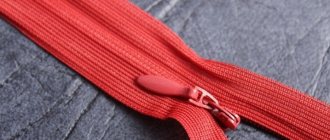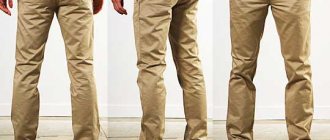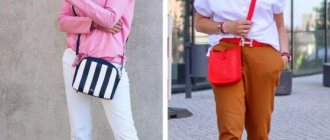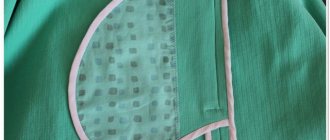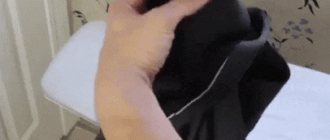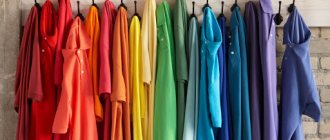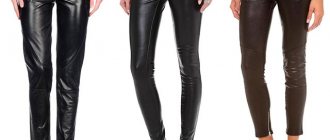The vast majority of models of men's and women's trousers are tailored to a specific type of human figure. For the perfect fit of products, they most often include such elements as a belt, tucks, folds and, of course, a codpiece. Not everyone knows what it is, but the importance of this seemingly inconspicuous detail of clothing is difficult to overestimate. In this article we will look at what a codpiece is, why it is needed and how to properly sew it into trousers.
Evolution
Few people know that during the times of knightly tournaments, when warriors wore heavy armor, such an element of combat attire as the codpiece was invented. That this is such an important invention and that it will reach our days, no one probably imagined. Of course, since those times the codpiece has changed beyond recognition.
Initially, it was a metal plate that served as a cover for the groin, its protection. This element of armor could look different - a small piece covering the male dignity, or even a rather large structure, which was attached in front above the groin, and from the back - to the belt above the buttocks.
Over time, others learned what a codpiece was. It was part of men's clothing (trousers, pantaloons), but its appearance was somewhat different than what we were used to seeing. This part was a rectangle that was attached to the trousers with buttons.
codpiece - the most indecent item in a man's wardrobe
Honestly, we don’t know how we didn’t notice this before, but it turns out that some paintings of the Renaissance, namely male portraits, can be called indecent.
The fact is that in those days, among the aristocracy, there was a fashion for codpieces - a detail of a man's wardrobe in the front of trousers or underwear. In Western European historical costume, the codpiece was made as a separate part of men's trousers, which was fastened to the front of the belt to cover the genitals. And for knights it was already a full-fledged element of armor, serving to protect the most precious.
By the 14th century, from a purely functional detail, the codpiece had also turned into a decorative one - representatives of the upper class decorated them with precious stones, elegant clasps and even fringe. And if this was not enough, then they fastened the item of clothing perpendicular to the floor in order to show off in front of the ladies and emphasize masculine strength.
A codpiece-pouch in a painting by Pieter Bruegel the Elder from 1565
Pietro Maria Rossi, Count of San Secondo, Parmigianino painter, 1530s
In English it is called codpiece.
Guidobaldo della Rovere, Bronzino painter, 1530s
In Ancient Rome, wearing pants was considered a barbaric and indecent tradition. It was then that both commoners and kings began to wear trousers, although often in the form of separate trousers, not sewn together in the middle. At that time, a detail called a codpiece appeared. Many people think that this is just a euphemism for a fly, but this is not true.
Family portrait of Henry VIII Tudor
The name “codpiece”, familiar to the Russian ear, is rooted in the Dutch language and the word gulp, which meant a pocket on men’s trousers, which carried the honorable mission of holding man’s dignity in its safe embrace. Dahl's dictionary reports a codpiece (codpiece or codpiece) as a lapel that was fastened to the belt at the front of the pants. There is even a legend that once Fabrizio, Duke of Bologna, hurried after a love meeting to appear before Henry VIII and Queen Anne Boleyn. Anna, noticing his impressive bulge in front, asked: “Is this an apple or are you just happy to see me?”
Nowadays, the codpiece is no longer the same. It turned into a strip of fabric that was sewn into trousers. Nothing remarkable! But under Henry VIII, the codpiece was an independent part of clothing, which was fastened or tied with ribbons tied in beautiful bows. Of course, it was simply impossible not to pay attention to such “bulging beauty.” So Anne Boleyn’s reaction is not surprising; she certainly had something to look at.
John Farnham, artist Steven van der Meulen, 1563
By the way, Henry VIII himself doted on codpieces. He not only wore them, but also made them a bright and remarkable part of the costume - quilted, with decorative slits, decorated with precious stones. And all because he wanted to demonstrate to all of Europe that he had something to boast about and how to conceive a male heir. Of course, the codpiece had not only a decorative purpose, but also a functional one - covering a prominent part of the body.
Fragment of a statue of Emperor Maximilian I
Initially, the codpiece was nothing more than an important part of knightly armor. It covered a place that was “superfluous in almost every battle,” and at first, even on the so-called Maximilian armor, it was made in the form of a bag of chainmail fabric. However, later they began to make it solidly forged and call it tapul. This element appeared on armor at the beginning of the 16th century and in German was called Schamkapsel, or “shame capsule.”
Then the piece of armor was called “codpiece” or “latz”. It looked like a real cap made of iron, which was connected to a metal belly using rivets or multi-colored ribbons. It is believed that this fashion originated with the Swiss - this is how they tried to defend themselves from the German landsknechts, who insidiously tried to hit them with a precise blow to the groin with a spear. At the same time, a fully formed metal codpiece appeared around 1520, but disappeared around 1570. It is interesting that on one of these codpieces, at the very end there is even a human face with a nose and mustache stamped on it - such a fantasy.
The metallic clank of the armor of knightly battles became the inspiration for medieval fashion to take its next turn and what was once necessary became fashionable, and at the same time its appearance changed quite a lot. Moreover, it changed not in accordance with the need to fulfill its original function, but at the behest of fashion. This is how it became an important accessory of Renaissance costume and a subject of male boasting.
Archduke Charles II, 1569
Some used the codpiece as a kind of pocket and hid small valuables and money there. Because it emphasized rather than concealed manhood, it was not approved by the Catholic Church. The priests were horrified by the new fashion and sharply condemned it. But, despite all the admonitions, fashion reached the point where bags were made for teenagers and small children.
Henry IV at the age of 4, François Bunel, 1557
Francois Rabelais describes the codpiece of the giant Gargantua in the following way: “The codpiece used sixteen and a quarter cubits of the same woolen material, and it was sewn in the form of an arc, elegantly fastened with two beautiful gold buckles with enamel hooks, in each of which an emerald the size of an orange was inserted.
By the way, this stone has the ability to excite and strengthen the reproductive organ. The protrusion on the codpiece protruded one and a half elbows; on the codpiece itself there were the same slits as on the pants, as well as lush puffs of the same blue damask silk. Looking at the skillful gold embroidery, at the intricate, jewelry-made wickerwork, decorated with real diamonds, rubies, turquoise, emeralds and Persian pearls, you would certainly compare the codpiece with a lovely cornucopia.”
Henry, Earl Howard of Surrey, 1546
Ballplayer with Page, Francesco Beccaruzzi
Exorbitant extravagance in costume decoration was replaced by laconicism, and the wardrobe itself was modified, acquiring more and more comfort. The ringing of precious metals and stones gradually gave way to the inaudible sound of a zipper being fastened or completely silent buttons. The codpiece today has remained in its original place, on which, depending on the item of clothing, buttons, a zipper or a special wedge-shaped flap appear, which provides a man with maximum comfort.
Young man, Georg Penz, 1544
Cranach the Elder, Joachim II Hector, 1520s
The codpiece has ceased to be a separate part of the toilet, becoming rather an area where it was once attached. If we are talking about trousers, jeans for men, then the codpiece is a zipper covered with a flap. But besides trousers, there are also leggings, panties, shorts, and even men’s tights - and all these items have “their own view” of the codpiece in accordance with the purpose of the clothing, the features of its cut and fabric.
Duke of Devon, 1550s
Gone are the days of knightly tournaments and royal boasting with jingling gilded codpieces studded with precious stones. Today, only hockey players who continue knightly traditions and, while defending the honor of their team, care about the safety of their own health, have the codpiece. The codpiece in everyday life has turned into an invisible zipper called a fly. However, designers with a sense of humor will come up with a model of panties for the stronger sex with an expressive codpiece and some kind of frivolous design or inscription.
Covering up the secret
The codpiece in the photo is an element of classic trousers (less often skirts). It is a fabric part that covers the slit between the left and right halves of the pants, fastened with a zipper, snaps or buttons. Another, but less well-known name for such an element of clothing is valance. It is very important for novice tailors to initially understand how important it is to be able to cut out and correctly sew in a codpiece, what it is in general, because this is perhaps the most significant place in trousers.
The codpiece is located in the front of the pants, in the most visible place; if it is sewn incorrectly, then the pants will sit unattractively, and such pants will be uncomfortable to wear. In addition, it is also necessary to learn to distinguish between concepts such as codpiece and slope. The first is the outer part behind which the fastener is hidden, the second is a piece of fabric that prevents underwear, underwear or skin from getting caught in the teeth of the zipper; a flap is inserted under the zipper.
How to sew a zipper into pants. Codpiece on trousers.
Hello, my dear readers of the blog “Sheysomnoy.rf”! Today we will learn how to make a codpiece on trousers , that is, sew a zipper into trousers. I would like to note that this is a very important skill, as it will give you the opportunity to sew your own trousers, jeans, and shorts. There are even skirts with a codpiece! After all, trousers without a codpiece will look like leggings; it serves as a decoration for the upper part of the trousers, as well as pockets. And at first glance it may seem that this is very difficult, but in the process of sewing you will understand everything, and it will turn out that sewing a zipper and making a codpiece is as easy as shelling pears. So let's get started!
We transfer the line of the center of the codpiece from the pattern to the part.
On the right part of the trousers we glue the codpiece with doublerin or non-woven fabric. Mark the lines of the center of the codpiece on the right and left sides of the trousers.
It is necessary to sweep the center lines with a contrasting thread.
Sew the middle seam on the trousers to the control point at the beginning of the codpiece. Iron the seam.
On the right side of the trousers, fold the glued codpiece along the marked line onto the wrong side and smooth it. On the left side of the trousers, cut off the codpiece, leaving a 1.5 centimeter allowance from the basted center line.
On the left side of the trousers, fold the cut codpiece, departing 4 mm from the marked center line, and wrap the rest on the wrong side.
Let's smooth it out.
To the left side of the codpiece we pin (or baste) a zipper close to the edge of the fold.
Important note: you need to have 3mm between the zipper stop and the top control point (the place where the seam allowance begins). Then the zipper will look beautiful when closed.
Now we make a slope . We cut it out from the main fabric (translate the codpiece piece from the pattern as in the photo below (we make a part with a fold, see photo point 1), but the slope should be 2 cm longer than the codpiece, so add another 2 cm to the length, not counting the allowances) .
We fold the slope face to face (see point 2), sew the lower sloping edge on the machine (see point 3), cut the allowance to 0.5 cm and make notches with scissors (see point 4). This is done so that when we turn the slope out, it does not puff up at the bottom.
We turn and smooth the slope (see point 5).
We sew the slope to the left side of the trousers, placing it under the zipper.
Remove the pins.
And we sew it on a machine, close to the edge. Use a special zipper foot (photo of the foot in this article).
Now we join both parts of the codpiece closely together the way it should look in the end. Pin or baste.
Turn the codpiece inside out. Now you need to sew the second part of the zipper in the right glued part of the codpiece.
To do this, hand stitch the zipper to the glued right side...
...and machine sew it close to the links. Here I want to note an important detail: the zipper at the top does not lie flat, but goes a little to the side by 3 mm.
Do not align the zipper, then it will not “pull” when closing.
From the front side we sew a decorative line for the codpiece. The bottom can be rounded, or you can leave a sharp corner (depending on desire and model).
And we sew on the machine the fold side of the codpiece at a distance of 1mm from the edge, and a decorative stitch. I stitched the stitch twice, as one stitch looked “flimsy”. For beauty, you can make zig-zig fastenings like in the photo.
From the wrong side we cut the zipper so that it hides in the slope allowances.
And we process the cuts using an overlocker or zig-zag.
All. Our codpiece is ready!
Maybe,
Important points
Sewing on the codpiece, which is the front part of the trousers and is also quite functional, requires care. An unsuccessfully opened zipper can simply “chew the fabric”, and then it will be difficult to avoid an incident. To protect yourself in advance from such awkwardness, you should not widen or narrow the codpiece; the zipper is sewn not to the trousers, but to the valance - this is a fundamental point.
There is a difference in how to sew a codpiece into women's and men's trousers. Thus, it is believed that the codpiece is attached to the right side of women's trousers, while for men, on the contrary, this part needs to be inserted into the left half of the trousers. If thin fabric is used for sewing, it is better to duplicate the codpiece and the slope, so the material will not wrinkle. However, this should not be done with thick fabrics - the product may turn out to be too rough.
Codpiece as a piece of clothing in our time
Over the course of a long evolution, the codpiece turned from a separate flap or pocket into a part of trousers. Currently, it is a zipper or button closure covered with a flap.
In addition to trousers, codpieces are now also found on men's underwear: briefs, leggings, men's tights, etc. In these products, the codpiece is a kind of vertical wedge that supports the male genital organ and ensures the convenience of performing natural needs.
Men's tights with codpiece
The recognized leader in the manufacture of men's underwear is the French company HOM, which in 1968 patented underwear with a flexible codpiece. And in 1997, the same company began to produce underwear with a horizontal codpiece. The vertical wedge was convenient primarily for right-handed people, but it created some difficulties for left-handed people when using it. The horizontal position of the codpiece made it universal for everyone.
Currently, the codpiece, although hidden from prying eyes, is still an important detail. It should ensure a comfortable position for the male genital organ, because a man’s health depends on it. That is why codpieces must be made from natural materials, even if the panties themselves are completely synthetic.
Having gone through a long evolution, the codpiece as a visible part of protective clothing remained only with hockey players. This, as you know, is the sport of real men, and men's health in hockey, a dynamic and contact game, is in serious danger. Currently, the codpiece is made comfortable, but invisible. Now, if it occurs to anyone to buy underwear with a decoration on the codpiece, it will be nothing more than a joke that will not go beyond the walls of the bedroom.
Women's codpiece as interpreted by Vaquera
Women want men, a career, money, children, friends, luxury, comfort, independence, freedom, respect, love and cheap stockings that don't run straight.
—Phyllis Diller
Codpiece cut
There are also differences in how the codpiece is cut out (photo of the blank above). This part can be one-piece or stitched. In the first option, when constructing the main pattern of the product, it is necessary to attach an additional element to the diagram - a valance, which is a rectangle 5 cm wide and 19 cm long. It is important not to forget to round the outer lower corner of the part. The slope is always cut out separately. For it you need to prepare a small piece of fabric in advance, it is better if it is the material from which the product is made. The size of the slope varies in the following ranges:
- Width (cut along the weft thread) – 7-8 cm.
- Length (along the lobar thread) – 18-20 cm.
After cutting and duplicating, the slope must be folded in half (along the long side) and sewn with an overlocker. It is also necessary to process the codpiece (one-piece valance) using an overlocker.
Zip fastening with one-piece codpiece facing
The one-piece facing of the codpiece is laid at the time of constructing the pattern: to the middle seam of the front part you need to add a rectangle 3.5-5 centimeters wide and 19-20 centimeters long. It can be rounded along one bottom corner, or it can be left straight.
Progress:
- Sew the middle seam to the cut mark on the fastener, folding the two front halves of the product with the right sides facing inward.
- Cut off excess fabric from the fastener allowance on the left half, leaving 1 centimeter.
- Cut out a slope equal to the length of the allowance and a width of 6 centimeters (for an allowance for facing the codpiece 4 centimeters wide), rounding the lower corners.
- Fold the slope in half with the wrong side inward and process the rounded side using an overlocker or bias tape.
- Baste the zipper under the left edge of the fastener, and baste the slope under it, aligning the edges. Sweep away all layers.
- On top of the zipper, along the edge, lay a stitch 2 millimeters from the edge.
- Process the right one-piece facing of the codpiece using an overlocker, then turn it inward and iron it.
- Pin the facing to the zipper tape.
- From the wrong side, unscrew the flap and the zipper tape so that it is convenient to lay the stitch. Turn the product right side out and mark a line of decorative stitching.
- Sew along the marked line. Make a fastening at the bottom of the codpiece facing with a narrow, frequent zigzag stitch.
Fine work
Directly sewing in a zipper and then removing the codpiece is a difficult and responsible task. It is very important that all the details are cut correctly and there are no distortions.
Before you start sewing, you need to make allowances for the zipper. To do this, on the left half of the trousers (women's, or the right - for men), draw a strip along the middle seam line, retreating 1 cm towards the outer edge of the valance. Then, bending the fabric along this line, sweep up the resulting allowance, and, placing the zipper under it with the left side, so that only the teeth are visible, pin it. Place the edge under the fastener, aligning its upper edge with the waistline of the trousers, and the lower edge with the other end of the zipper, then stitch it. Place the trouser legs together, aligning them along the middle seam (right sides). And sew the zipper (the right, free side, if the trousers are men’s, then the left side) to the right valance.
After sewing in the zipper, the middle seam needs to be sewn, connecting the centers of the trousers. The line should be laid to the limiter on the lock, not reaching half a centimeter from it. The last, final stage will be to lay a finishing stitch along the codpiece so that the seam is even. It should be laid along a pre-planned line.
Processing the codpiece fastener
In this case, the product is without a belt, with a facing at the top. If with a belt, we do the same thing but do not grind the upper cut of the slope. So, left center is the codpiece. I have it cut off, its outer edge is overcast. On the right is a slope, it is double, its inner edge is overcast, it is stitched at the top and bottom. Double slope with a fold, stitch short sections of the top and bottom from the inside, turn out and iron. Sweep the remaining raw cut.
On the slope we adjust the zipper to the edge, bend the corner of the zipper inward, then it will hide. Because We have a product with a fastener on the female side, we bend the middle section of the left trouser leg to the width of the hem and iron it, put our slope under it with a stitched fastener, pin it perpendicularly.
We adjust it to the edge.
We sew the codpiece to the right side
Ironing the seam allowances
And we press the codpiece inward, forming a 0.2 cm edge from the main part
We mark a line of alignment, which is equal to the width of the seam allowance along the seat, i.e. 1 cm.
We apply and pin the upper part of the fastener to it.
We turn this whole thing over to the reverse side and pin the free side of the zipper tape to the codpiece (the main part under the codpiece is not pinned)
We bend and adjust the zipper tape to the edge of the codpiece.
On the top of the slope we sew a buttonhole, preferably in advance.
Next, we still have unstitched sections of the middle seam below the fastener.
Sew with a centimeter seam
Leading the line to the junction of the one located above.
We sew and stitch (if designed according to the model) the back seam of the seat, in the same direction as the front fastener.
We also sew off the middle seam at the front, if provided according to the model.
We sew the crotch seams, matching the lines.
We pin the prepared waist facing perpendicularly with needles and stitch it.
Fold it up and adjust both facing allowances by 0.2 cm from the front side.
Then we cut off the allowance of the upper cut of the product itself, i.e. the part from which the edging needs to be formed.
Iron the top edge; I recommend basting the seam allowance first. We sew a short section of the facing on the side with hidden stitches to the codpiece allowance. Sew on the button.
We lay a 3-3.5 cm finishing stitch on the front side. It is better to do this in two stages: first, a straight parallel line from the bottom up with the zipper open, then a rounded one at the bottom with the zipper closed.
Ready. General view from the inside.
And a general photo
